| Reply to Thread New Thread |
|
|
#1 |
|
|
The only certainties in life are death and taxes, according to Benjamin Franklin.
So you’d think that as we're certain that death will definitely happen to us, one day, we'd make pretty damn sure that we knew a heck of a lot about it. But no. We have every kind of instruction, information, advice and guidance on how to live — but none on how to die. And in the West, we live in denial about death. We hide our dead bodies away and if anyone talks about death, they're accused of being morbid. It wasn’t always so. Going back into prehistory, the shaman of the tribe would act as the psychopomp, and guide or carry the souls of the dead into the next dimension. As you can see from this Wiki page on psychopomps, he or she appears in the mythology of just about every ancient civilisation. This is because shamanic practises were worldwide and people were taught how to die. http://en.wikipedia.org/wiki/Psychopomp Many religions include a particular spirit, angel, or deity whose responsibility is to escort newly-deceased souls to the afterlife. These creatures are called psychopomps, from the Greek word ψυχοπομπός (psychopompos), literally meaning the "guide of souls". Their role is not to judge the deceased, but simply provide safe passage. Frequently depicted on funerary art, psychopomps have been associated at different times and in different cultures with horses, whippoorwills, ravens, dogs, crows, owls, sparrows, cuckoos, harts, and dolphins. Charon was the Greek ferryman, or psychopomp, who ferried the souls of the dead from the land of the living to Hades. The actual journey isn’t anything like this painting of it, by Luca Giordana. But it shows how we, in our ignorance about death, have come to view this natural rite of passage as a chaotic and terror-filled nightmare. The Barque of Charon 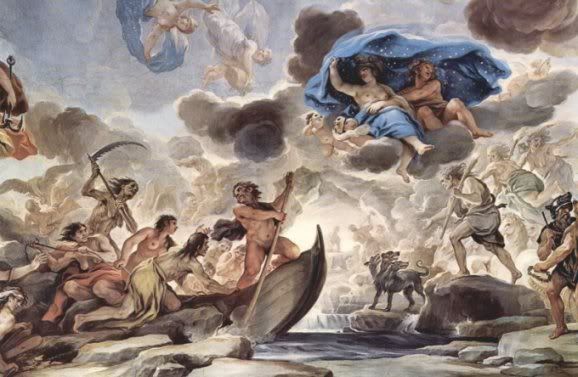 Perhaps the most recent literary psychopomp is Virgil, who conducted Dante through the nine circles of hell in Dante’s Inferno. But that work is political more than spiritual and even worse, you can't even appreciate the poetry because it was written in an obsure Tuscan dialect that no longer exists. However, going back before Dante and the post-Plato Greeks, these mythological stories were in fact used to teach the death journey ... the journey the soul would take at death. And the practice was carried on in the Neolithic and onwards by the Tibetans, the Indians and the Egyptians at least ... and possibly others that we don’t yet know about. Sadly, in the past two thousand years, the historicisation of myth — making metaphor literal — has destroyed this body of knowledge. We are taught nothing about the death journey because nobody seems to know anything about it apart, that is, from those who return from having a Near Death Experience (NDE). But it’s still not much help. If a person "returns from the dead", it means that they never got any further than the first gate out — the tunnel, or the string of String Theory that takes us into the next dimension. Detail from The Last Judgement by Hieronymus Bosch  If you go any further than the tunnel, you can’t get back, unless you’re a psychopomp who has all the right ‘open sesames’ and who knows the way. So NDEs still can’t give us much information. It’s like if you were trapped in a nightclub basement and tried to escape. You get as far as the door at the top of the stairs, but the bouncers turn you back. Then, on your return, you exclaim: “Oh my God! You should have seen it! It was so divine! There was a brilliant, luminescent, other-worldly light shimmering over the door,” when in fact it was just the flashing neon sign saying EXIT.  The reason there are no teachers now on how to die is because empirical science has debunked literal Judaeo-Christianity. We know there’s no heaven with angels and harps, or a hell with a horned Devil who roasts sinners who all moan and gnash their teeth. So we’ve rejected the whole lot now. Imo, we’ve rejected it quite rightly as literal truth about this reality, because it is a fiction – and bad fiction at that. But that bad fiction (for example, the Genesis creation story, Noah’s Ark, the Exodus across the Red Sea, the Crucifixion ... and even the story of Atlantis) was based on much more ancient stories that existed for a very real purpose. They made up different stages of the death journey. This journey was taken at night by the Egyptians, where the deceeased followed the arc of the sun from sunset to its eventual sunrise in the Land of Manu (the East or India). That is why this night journey of the soul of the deceased is known to the Egyptians as The Coming Forth Into Day. It is a story of death and rebirth, as the soul is reborn with the Sun at dawn.  In other words, it was the manual for how to make the transition into the next dimension at death. It was the manual on how to die. 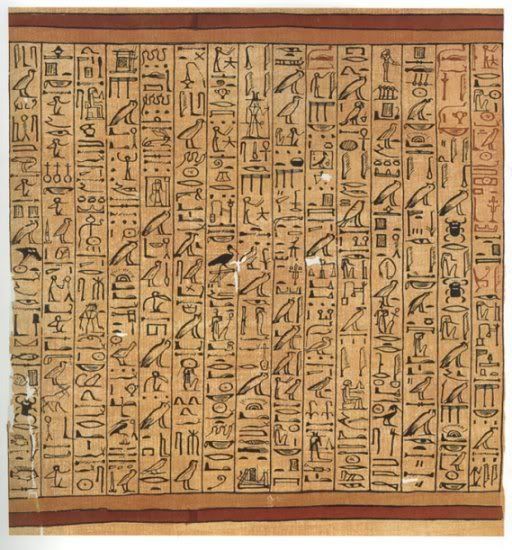 So in this thread, over the next few weeks, I’m going to look at what these death journeys actually were about by bringing in the Pyramid Texts and the Coffin Texts. The other manual still left to us, of course, is the Tibetan Book of the Dead. And if it is helpful and relevant, I will also use my own experiences as a shaman and psychopomp to make interpretations. But please feel free to interrupt me at any time, if something doesn’t make sense, or even if it’s just to make a comment or a joke or to tell me I'm talking a load of crap or something. As you all know, I’m perfectly capable of talking to myself for hours on end ... but it’s nice to have company! |
|
|
|
|
#2 |
|
|
As you all know, I’m perfectly capable of talking to myself for hours on end ... but it’s nice to have company! I am here and paying attention,
I have given the topic of death lots of thought, I keep trying to figure out how to choose a good life next time, do I even get that much of a choice of where to go, and what will I have in the way of decision making tools when I am at that point. I look forward to your ideas. |
|
|
|
|
#3 |
|
|
Well now -
My almost 90 year old mother Decided back in the fifties that When she died she would metamorphose Into a Raven living on the rim of the Grand Canyon, in Arizona. I do believe she will. And the Grand Canyon Ravens are prima ballerinas of the aerial. That struck me very much as a child. My choice - or is it premonition - is being An Otter, any Otter At play in the river of life, After I do die do die do............ hoka hey john |
|
|
|
|
#4 |
|
|
"It's a new dawn.
It's a new day. It's a new life. And I'm feeling good." Nina Simone The ancients saw death as a kind of initiation. It may be difficult to understand because the word 'initiation' is a strange one to us today. Its meaning has been lost, or perhaps been turned into something strange and wrong, like secret rites into a weird cult. This is because Constantine's Christianity, in the fourth century, wiped out all initiations, leaving only the relatively empty one of the Christening. The Jews hung on to their most important one, that experienced by young boys at 14 years of age (which they call the 'bar mitzvah'). But the death 'initiation' journey described in allegory as the Exodus in their scriptures has become to them an actual historical exodus of the Jews out of Egypt. So once again, the meaning, and thus the true purpose, of the initiation has been lost. We see a remnant of its original meaning in the New Testament with the saying of John the Baptist: "I have come to baptise you with water, but one who is greater than me will come and baptise you with Spirit and Fire." But we don't hear any more about this baptism of Fire until later on, in Acts, when the disciples are gathered in a room and the Holy Spirit descends with tongues of Fire. 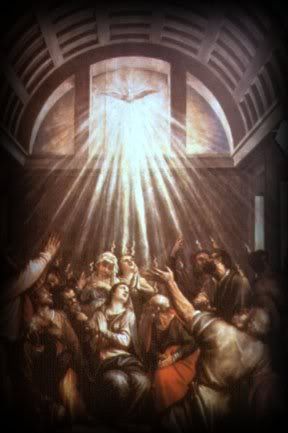 After that, we have Paul's enlightenment on the road to Damacus, where the light from the Fire descending from the Spirit causes him to fall off his horse and temporarily blinds him: 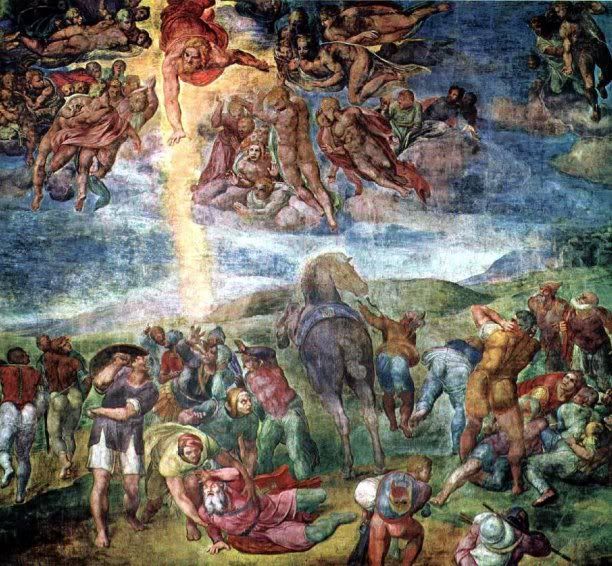 An initiation is a rebirth into a new life. In Paul's case, he signifies this by changing his name from Saul to Paul. The word 'initiative' which derives from the word 'initiation', has all the connatations of life and not death. When we start something new, we 'initiate' something. When we are at a crossroads of indecision, when all our previous knowledge fails us, we have to use our 'initiative', a wellspring or inSPIRIration of wisdom that brings vision and clarity or 'new life' to a previously unresolveable dilemma. The ancients saw death as an initiation - the final initiation of this life, having travelled through several initiations in their lives to get there. The Greeks would sacrifice a cock at all their initiations. As Socrates was being taken to his execution, his final initiation, he said to a friend: "I owe a cock to Asclepius", Asclepius being their 'god' at the time. The story of the crucifixion of Jesus is the story of an initiation, based on the Egyptian death journey called the Coming Forth By Day, which Exodus was also based on. The Jews' bar mitzvah is typical of manhood initiations in most shamanic societies in that it takes place at age 14. We see this in some African tribes even today, where the young boys of the village are taken, at around the age of 14, out of the village and into the wilds, where they stay with the shaman and the elders for a number of days, and sometimes weeks, until they pass their initiation. The passing of the initiation usually involves an act of courage involving the supernatural, or an act of initiative where the young boy can no longer rely on his elders to help him. This is his dragon-slaying moment, known to us from so many ancient myths. Just as a cold snap in Spring forces the sap up a flower stalk so that it can blossom, so crisis forces rebirth. Revolution is the precursor to evolution. Insurrection is the precursor to resurrection. Thus, when he returns to his village, the boy is no longer a boy but a man. This is how boys become men in shamanic societies. Manhood is not just something that is attained automatically at a certain age of adulthood. It has to be earned and attained. It is process, a natural growth development that takes place under certain contrived and catalytic conditions, and not an automatic right. And some boys don't make it ... African boys at initiation ceremony 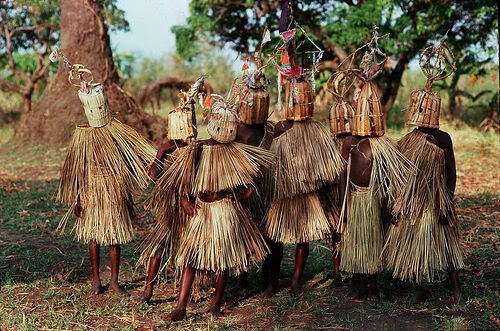 Most of the scriptures of the modern day religions - Judaism, Christianity, Zoroastrianism, Islam, Hinduism - were originally stories of these shamanic initiations. They usually have several common components whereby we can recognise the journey of the hero (initiate) as he meets and faces his challenges, and these are very well described in Joseph Campbell's book, The Hero With A Thousand Faces. A full description of an actual shamanic initiation which still takes place for young boys in Burkino Faso, Africa today can be found in Malidoma Patrice Some's book Of Water and the Spirit. More about Malidoma Patrice Some. Our ancestors saw everything as circular, and not linear as we do today. They understood the cyclical nature of every living thing from their study of Nature and their inner, shamanic journeys into fractal or quantum realms. From their megaliths, we can see that they understood that the astronomical processes were cyclical and revolved around one another. They knew enough about this to be able to align their earthworks and henges towards the sun's nadir at the winter solstice (the "death of the sun") - they knew where on the horizon this would occur. They understood the concept of 'as above, so below', in other words, that if this revolved or went round: Atom 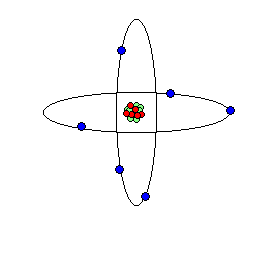 Then so did this: Solar system  They knew that revolution was the precursor to evolution. And as man is part of Nature, (and not separate to it as we see ourselves today) then his evolution will also necessitate its precursor - revolution. He will 'go round' too ... not in his body, which he shrugs off at death like an old, worn out overcoat, but in his Spirit, which was taken from him and made to appear as separate to him in the naming of it 'Holy Spirit'. The Egyptians called their death journey, or final initiation, the Coming Forth By Day or Coming Forth Into Day as it followed the journey of the arc of the sun at night through to day. Just as the sun lights up the sky in a carnival of reds at daybreak, and a baby is born smeared in red blood, so the corpse of the deceased, smeared in red hematite, was seen as going towards a new dawn, a new day, a new life. "It's a new dawn. It's a new day. It's a new life ... for me, And I'm feeling good." |
|
|
|
|
#5 |
|
|
The person seeking the initiation is called an 'initiate'. In some traditions, he is also called an 'adept'.
So as we're on the subject of initiations, I thought it might help to deepen our understanding about their nature and purpose if we had a discussion on this old chestnut - the Sumerian story of Adapa, or Adapa the Adept. The meaning of this story is argued about by scholars, and they come up with some quite wild speculations, so don't be afraid to express any of your own ... you would be in good company! First of all, I will give a summary of the story. Then we can look at the exact transcription as it appears on the Sumerian tablets. After that, I will invite your ideas of what this story is about in the context of what we know so far about initiations. I won't give my opinion until others have had their say. Adapa the Adept Once upon a time, in the land of Sumeria, there lived the wise priest Adapa. Adapa  Adapa (also known as Adamu) was the son of Ea, the wise serpent. Ea, the wise serpent 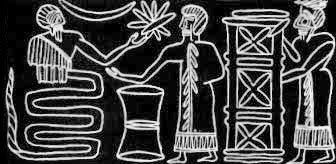 Because of his illustrious birth, Adapa was already proficient in the wisdom that his father taught him. He was, in fact, a semi-divine being and a priest at the temple of Ea. But Adapa had not received the ultimate initiation, that of becoming an immortal or being granted eternal life as a god. However, one day, Adapa was fishing out at sea, when the south wind suddenly blew up a squall and the upshot was that Adapa's boat overturned and the poor man was given a good drenching. He managed to save himself and get his boat upright again. But by now, he was so angry, he struck out at the south wind and broke its wings. Thus the south wind was so injured that it couldn't blow its coolness over the land for seven days, and this caused a terrible drought. Anu, the main godhead, was furious at Adapa and summoned him up to heaven for a good dressing down. But before he went, his father Ea gave him advice about how to conduct himself there - if he wanted to get out alive! Anu 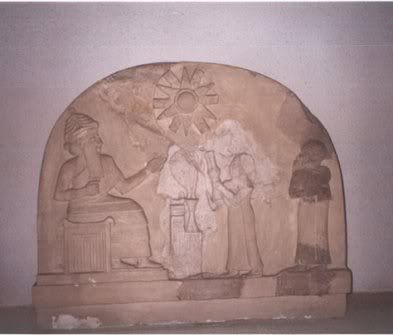 So Ea teaches his son Adapa how to trick Tammuz and Gishzida, the gatekeepers of heaven, so that they will let him in. Tammuz and Gishzida, gatekeepers of heaven 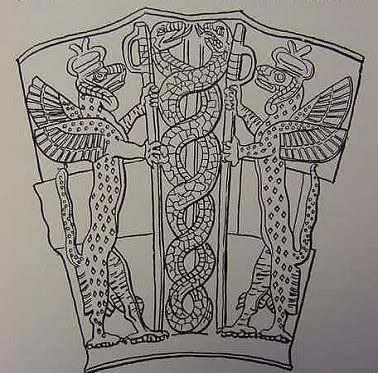 Ea also warns Adapa not to eat or drink anything in heaven, as this could be fatal to a mortal. So with his father's advice still ringing in his ears, Adapa sets off for heaven. And when he gets there, Ea's advice instantly proved its worth as he was able to trick the gatekeepers into letting him in. When he meets Anu, Anu welcomes him and sets before him a veritable banquet of wonderfully delicious food and drink. However, Adapa, remembering his father's words, declines this hospitality. But what Adapa didn't realise was that the food was no ordinary food. It was, in fact, the food of immortality and if he had eaten it, he would have become an immortal, a god. So in refusing this food, Adapa in effect, lost out on the chance to become a god, and he has to return to Earth and continue his days as an ordinary mortal. Exact transcription Here is actual transcription of the story from the Sumerian tablet. Where there are dots like this: ........ it means that there is a lacuna in the tablet, and so that writing is missing: TABLET NO.1 He possessed intelligence . . . , His command like the command of Anu ... He (Ea) granted him a wide ear to reveal the destiny of the land, He granted him wisdom, but he did not grant him eternal life. In those davs, in those years the wise man of Eridu, Ea had created him as chief among men, A wise man whose command none should oppose, The prudent, the most wise among the Anunnaki was he, Blameless, of clean hands, anointed, observer of the divine statutes, With the bakers he made bread With the bakers of Eridu, he made bread, The food and the water for Eridu he made daily, With his clean hands he prepared the table, And without him the table was not cleared. The ship he steered, fishing and hunting for Eridu he did. Then Adapa of Eridu While Ea, ... in the chamber, upon the bed. Daily the closing of Eridu he attended to. Upon the pure dam, the new moon dam) he embarked upon the ship, The wind blew and his ship departed, With the oar, be steered his ship Upon the broad sea . . . TABLET NO. 2 ................. The south wind .... when He had driven me to the house of my lord, I said, O South wind, on the way I shall to thee ... everything that, Thy wing, will I break." As be spoke with his mouth, The wing of the South wind was broken, seven davs The South wind blew not upon the land. Anu Called to his messenger Ilabrat: Why has the South wind not blown upon the land for seven davs? His messenger Ilabrat answered him: "My lord, Adapa, the son of Ea, the wing of the South wind Has broken." When Anu heard these words He cried, Help!" He ascended his throne, "Let some one bring him," Likewise Ea, who knows the heaven. He roused him ... he caused him to wear. With a mourning garment He garbed him, and gave him counsel Saying: " Adapa, before the face of Anu the King thou art to go ... to heaven When thou comest up, and when thou approachest the door of Anu, At the door of Anu, Tammuz and Gishzida are standing, "they will see thee, they will ask thee; 'Sir,' For whose sake dost thou so appear, Adapa? For whom Art thou clad in a mourning garment?' 'In our country two gods have vanished, therefore Am I so.' 'Who are the two gods, who in the land Have vanished?' 'Tammuz and Gishzida.' They will look at one another and Be astonished. Good words They will speak to Anu. A good countenance of Anu They will show thee. When thou standest before Anu Food of death they will set before thee, Eat not. Water of death they will set before thee, Drink not. Garments they will set before thee, Put them on. Oil they will set before thee, anoint thyself. The counsel that I have given thee, forget not. The words Which I have spoken, hold fast." The messenger Of Anu came: "Adapa has broken The wing of the South wind. Bring him before me." The road to Heaven he made him take, and to Heaven he ascended. When he came to Heaven, when he approached the door of Anu, At the door of Ann, Tammuz and Gisbzida are standing. When they saw him, Adapa, they cried: " Help, Sir, for whom dost thou so appear? Adapa, For whom art thou clad in a mourning garment?" In the country two gods have vanished; therefore am I clad In mourning garments." "Who are the two gods, who have vanished from the land?" "Tammuz and Gishzida." They looked at one another and Were astonished. When Adapa before Anu, the King, Drew near, and Anu saw him, he cried: " Come hither, Adapa. Why hast thou broken the wings Of the South wind? " Adapa answered Ann: " My lord, For the house of my lord in the midst of the sea, I was catching fish. The sea was like a mirror, The South wind blew, and capsized me. To the house of my lord was I driven. In the anger of my heart, I took heed." Tammuz and Gishzida Answered ... "art thou." To Anu They speak. He calmed himself, his heart was . . . "Why has Ea revealed to impure mankind The heart of heaven and earth? A heart ... has created within him, has made him a name? What can we do with him? Food of life Bring him, that be man, eat."Food of life They brought him, but he ate not. Water of life They brought him, but he drank not. Garments They brought him. He clothed himself. Oil They brought him. He anointed himself. Anu looked at him; he wondered at him. " Come, Adapa, why hast thou not eaten, not drunken? Now thou shalt not live." ... men ...Ea, my lord Said: "Eat not, drink not." Take him and bring him back to his earth. ... looked upon him. TABLET NO. 3 "When heard that In the anger of his heart His messenger he sent. He who knows the heart of the great gods ............ To King Ea to come, To him, he caused words to be borne. ... to him, to King Ea. He sent a messenger With a wide ear, knowing the heart of the great gods, ... of the heavens be fixed. A soiled garment he made him wear, With a mourning garment he clad him, A word he spoke to him. "Adapa, before the King Anu thou shalt go Fail not the order, keep my word When thou comest up to heaven, and approachest the door of Anu, Tammuz and Gishzida at the door of Anu are standing. From Sacred Texts So discuss! You might find it helpful to think about the following questions: 1. What has this story got to do with initiations? 2. What does it tell us about the nature and purpose of initiations? 3. Did Adapa pass or fail the initiation? |
|
|
|
|
#6 |
|
|
my lack of sleep makes your questions hard, but here are my first thoughts.
I would say that Adapa failed the initiation, I always thought that initiations are to keep the unworthy from getting power that they would mis use, I think it is a great story of what happens when you try to cheat your way through an initiation. |
|
|
|
|
#7 |
|
|
Ishtar -
First, hair on the back of the neck hit. Powerful similarities to the Grail Muthos. Second, hair on the back of the neck hit. Coyote, the Trickster. Is it possible they had a single, individual root? O jeez, more homework.............. And by the way the Irish too; The Hawk's Well (W.B. Yeats) Is all about this. hoka hey john |
|
|
|
|
#8 |
|
|
Both
I'm sorry, spacecase0. I gave the questions with the aim of helping, not to make it difficult. But your answer agrees entirely with my interpretation. After all, we can't have immortal gods going around who see everything from a human-centric point of view and lose their temper when their small, individual aims are diverted or disrupted by the needs of the greater whole. Interestingly and coincidentally (if you believe in coincidence), this matter was also discussed from a different angle yesterday in Cognitive Crossings. John, it was interesting that you picked up on the Grael and the Hawk's Well as examples of stories about thwarted immortality. Another one is the Epic of Gilgamesh where Gilgamesh, like the old man at the Hawk's Well, falls asleep at the pivotal moment. And an example of a life-giving cauldron is the Celtic story of the battle between Bran's men and the Irish king which is illustrated on the Gundestrop cauldron. And you also brought up the idea of the Trickster god, John. This is what scholars argue about. Did Ea deliberately mislead his son Adapa by telling him not to eat the food, so that he wouldn't be given immortality? Or was it a mistake, a failure of Adapa to transcend parental controls and use his initiative? Of course, with all the lacunas on the tablets, it's difficult to feel that you have the whole story, especially as, like the old man at the Hawk's Well, it tends to collapse at the pivotal moment! However, in all civs stories about the Underworld or the Nether Worlds, the hero is always told beforehand on no account to touch the food or they will remain trapped there for eternity. There are terrible tales in Ireland, even today, about men who disappeared because they accidently fell in with the fairies, dancing on their raths, on a drunken stumble back from the pub one night. These poor fellows were forced to stay forever in the fairy kingdoms, and to be married to the beautiful fairy queen, and to be waited on hand and foot in a royal life of luxury by nubile nymphs forevermore, just because they ate the food - when they'd have much rather got back to their pigs, their peat cutting and their nagging wives! Titania (Queen Mab)and Oberon 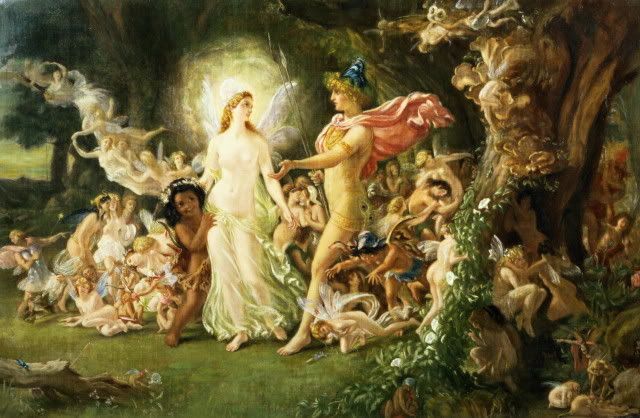 But on Trickster Gods, the late great George Carlin came up with this explanation about their sacred function, (with my bolding): "Many native traditions held clowns and tricksters as essential to any contact with the sacred. People could not pray until they had laughed, because laughter opens and frees from rigid preconception. Humans had to have tricksters within the most sacred ceremonies for fear that they forget the sacred comes through upset, reversal, surprise. The trickster in most native traditions is essential to creation, to birth".[1] Where he used the terms of upset and reversal, in the previous post I explained about how revolution causes evolution and insurrection is the precursor to resurrection. Some shamans include what's become known as 'sacred clowning' in their repertoires for this reason, and others perform something called The Theatre of the Absurd. Reynard the fox, a literary development of Coyote 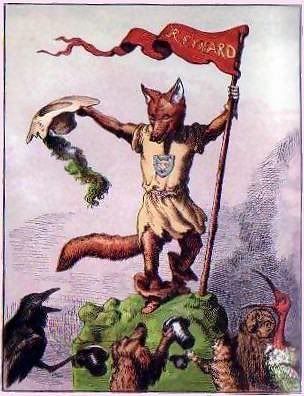 So spacecase0, you get 10 out 10 and can go instantly to the top of the class. But John, as usual you raised more questions than you answered, so please see me in my study after school! (Thanks for the discussion! See you guys in a couple of days.) |
|
|
|
|
#9 |
|
|
I know a Sacred Clown, a French man by the name of Didier Danthois
 Didier is very deeply schooled in the Tibetan Buddhist/Bon tradition and also uses Indian ragas in his performances. He told me that his favourite book is The Tibetan Book of Living and Dying by Sogyal Rinpoche. That book is an updated version of The Tibetan Book of the Dead, which is where we came in. |
|
|
|
|
#10 |
|
|
getting stuck in the fairy world seems not half bad.
was it only men that got stuck ? I bet it was only the men that ate the food knowing what it would do. I sent this thread to my mom, and she loved it. I'm sorry, spacecase0. I gave the questions with the aim of helping, not to make it difficult. it is fine, it is my fault, I was just very very tired that day and had a hard time thinking, I am better now. I have noticed that the SGI Buddhist group often laughs at the beginning of events, I like your idea of why. |
|
|
|
|
#11 |
|
|
Well, I've nothing profound to add. Either I'm mellowing, Ish - or you're really getting good at this, but I've really enjoyed your posts here, particularly the first one. Even when you sail right off the edge of the map you always have an absolutely valid reason.
I suspect the relationship to death is (amongst other things) partially what first drew me to Mesoamerica. I'm not quite sure how to explain it but it feels kind of like innoculating oneself to death or at least fear of death by becoming immersed in it, like taking back some power. I'm not claiming this as any great insight by the way as I suspect it's the very same reason teenagers wear black and listen to whatever the hell they're istening to these days. |
|
|
|
|
#13 |
|
|
|
|
|
|
|
#14 |
|
|
This prayer from the Buddhist master, Shantideva, echoes that of the pyschopomp:
May I be a protector to those without protection A leader for those who journey And a boat, a bridge, a passage For those desiring the further shore. May the pain of every living creature Be completely cleared away May I be the doctor and the medicine And may I be the nurse For all sick beings in the world Until everyone is healed. Just like space and the great elements such as earth, May I always support life of all the boundless creatures. And until they pass away from pain May I also be source of life For all the realms of varied things That reach unto the ends of space. In actual fact, the Realms of the Dead themselves are the healer, the doctor, the nurse and the medicine which provide the means for the human being to 'pass away from pain'. This is my experience. Upon reaching the Realms of the Dead, the first place you encounter is the Forest of Despair. The trees in the Forest of Despair are enormous, much bigger than even our biggest red oaks or rainforest trees - and their branches are covered in leaves that are very lush and very green. At first, this forest can seem enormous to the tiny being who has to traverse it. But we are in a place of no time and no space ... The purpose of the Forest of Despair is to actually eat or transform the despair the suffering soul may be experiencing, either as a result of the mental and emotional scarring that took place that during their lifetime, or the physical pain they experienced while dying.  Where trees on earth 'eat' the carbon dioxide exhaled by human beings and turn it into oxygen, so the trees in the Forest of Despair eat the pain and suffering of the human being, and turn it into joy and peace. This healing has to be achieved before the soul or being can carry on their journey into the Realms of the Dead, which are very beautiful, and so much so that the Beauty itself is healing. There will be much loving healing to follow, but the Forest of Despair is the first one. |
|
|
|
|
#15 |
|
|
Ishtar -
Well, you've done it again. Raised the hair on the back of my neck plus The physical frisson of hyper-awareness. I live on the Olympic Peninsula, an ancient upthrust of mountains And rivers and temperate rainforest. http://www.arthurleej.com/a-peninsulatrees.html http://www.terragalleria.com/parks/np.olympic.3.html The forest on the upper Hoh River is sacred ground to me, And rather than a Forest of Despair, to me It is a Forest of Delight. It is no accident that I am here. Like the steelhead and salmon, my life invisibly And intuitively led me to my native water. It just took 50 years, beginning with my birth In North Carolina. As in the Dark Matter thread, There is a hell of a lot more transparency, and migration Between Dark and Light, Life and Death, than Is generally imagined. Walk for a few miles in the Hoh rainforest, then, suddenly, you Are on the bank of the river, white jade of glacial melt Meeting sky blue or sky black and slashing rain, Or sky grey with the sumi-e swirl of snow. It all fits. That simple. hoka hey john |
|
|
|
|
#16 |
|
|
Where trees on earth 'eat' the carbon dioxide exhaled by human beings and turn it into oxygen, so the trees in the Forest of Despair eat the pain and suffering of the human being, and turn it into joy and peace. I am sometimes worried that the trauma of life will mess me up in the next life, now I am not worried anymore, thank you. |
|
|
|
|
#17 |
|
|
To understand ancient man, we must understand how he thought. And one way he was different to us was that he was almost obsessed with what would happen to him after his death. I say ‘almost obsessed’. But really that’s just a value judgement based on how we think today. I hope I'm not being too presumptuous when I say that those of us who don’t belong to religions are either in complete denial about death or pretend that we couldn’t care less about it. Because modern Western science has decided that everything is meaningless, we don't understand the meaning of our life, let alone our death. We don't think we can do anything about what happens when we die, so we just sweep the whole idea of it under the carpet.
However, we know from the ancient literature, rituals and paintings that ancient man had a very different view: He understood that the meaning of this life was to provide a sort of springboard to the next, and he used it accordingly. He thought about eternity a lot. In the Vedas, we find astronomical cycles of trillions upon trillions of years. Those that disseminated these teachings had no doubt that there were other dimensions because they were shamans (rishis) that journeyed to them. And all their architecture across India and Mesopotamia (Sumerian, Indian and Egyptian) was built according to sacred geometrical principles derived from “the heavens” to represent their understanding of endless time. With the orientation of the heavens, sacred space in Egyptian architecture also represents a chronotype, a dimension were heavenly time reigns. To build a sacred space was to establish not only a spatial but also a temporal link with the heavens. It was a realisation of eternity. Assmann (1996: 59-60). Because of this understanding about eternity, ancient man had a different perspective to us. This life on earth seemed tiny by comparison and so their efforts were dedicated the journey of existence, to the growth of the soul, and not just this one small existence that would be gone in a blink of an eye. Going back to the earliest cave art in Egypt, we see evidence of that in what later became the Journey of Coming Forth into Day. We know very little about pre-Dynastic Egypt, although the rock art suggests that late-Naqada III and the early Dynastic periods were remarkably similar, and that it is probably a matter of complexity matching the social order emerging during that time span (4,000 to 3,000 BCE). These rock paintings are highly suggestive that the story of the Day Journey to the stars (and perhaps a Night Journey as well) is at least pre-Dynastic. The Twelve Gates by John Rush. But once we get into the art from the Old Kingdom proper, we can see more clearly how this death journey developed. http://www.metmuseum.org/toah/hd/oking/hd_oking.htm Egypt's Old Kingdom (Dynasties 3–6, ca. 2649–2150 B.C.) was one of the most dynamic periods in the development of Egyptian art. During this period, artists learned to express their culture's worldview, creating for the first time images and forms that endured for generations. Architects and masons mastered the techniques necessary to build monumental structures in stone. Sculptors created the earliest portraits of individuals and the first life-sized statues in wood, copper, and stone. They perfected the art of carving intricate relief decoration and, through keen observation of the natural world, produced detailed images of animals, plants, and even landscapes, recording the essential elements of their world for eternity in scenes painted and carved on the walls of temples and tombs. These images and structures had two principal functions: to ensure an ordered existence and to defeat death by preserving life into the next world. To these ends, over a period of time, Egyptian artists adopted a limited repertoire of standard types and established a formal artistic canon that would define Egyptian art for more than 3,000 years, while remaining flexible enough to allow for subtle variation and innovation. Catharine H. Roehrig,Department of Egyptian Art, The Metropolitan Museum of Art Unfortunately, though, the first people to find these ancient paintings and artifacts were historians of one kind or another, and most historians are only really interested in what happens to a country politically, over time. Therefore, we have the most monumental misunderstandings about much of the tomb art and some of it is still going on today. What is a battle that takes place in the mythological death journey where the deceased has to defeat the Apoph monster becomes, in the hands of the historians, a story about a king uniting upper and lower Egypt, and this despite there never being any evidence that the two were ever apart. This is not king Narmer, as historians will have you believe. It’s Osiris. Narmer palette, c. 3000 BCE 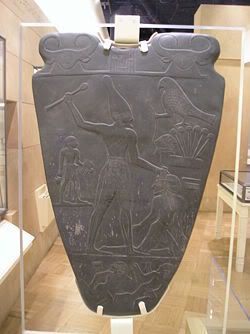 The same misunderstanding occurs over this painting: From the tomb of Seti I 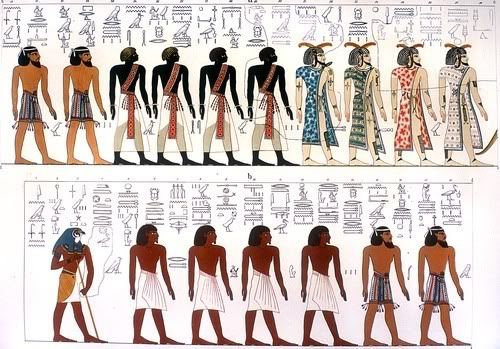 Some say that it is conquered Nubians, Egyptians, Syrians, Berbers, and Canaanites queuing up to pay homage to Seti the Pharaoh. This despite the fact that they are all walking away from said 'pharaoh’ - but that's because he isn’t a pharaoh at all but the hawk-headed Horus. Horus 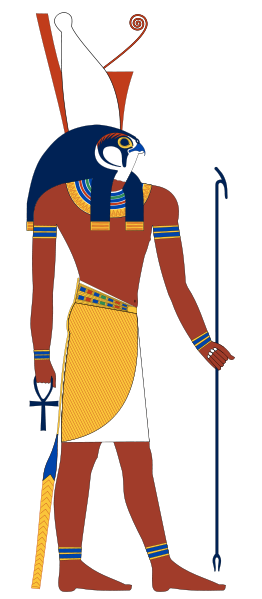 Now let's see what the Pharaoh Seti I really looked like. Here we see Seti between the hawk-headed god Horus and the jackal-headed god Anubis, as they guide him on a part of his death journey.  Here we see Horus introducing Pharaoh Seti to the god of the underworld, Osiris and his wife, Isis. 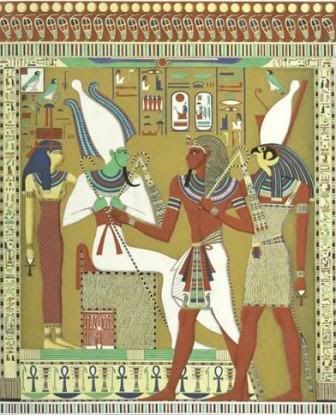 Then others insist that the ancient Egyptians must have been black because Osiris, the god of the underworld, is sometimes black. But as is apparent from the painting from Seti’s tomb above, Osiris can also be green, and that’s because the colour too is symbolic and changes according to the message of the scene. Green Osiris 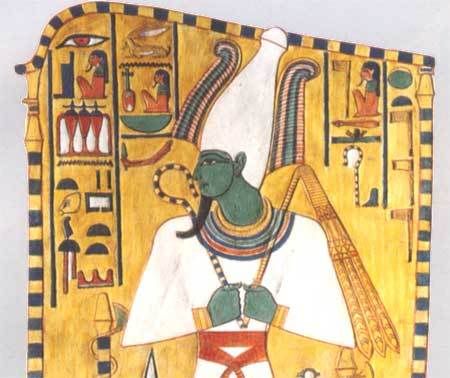 Black Osiris 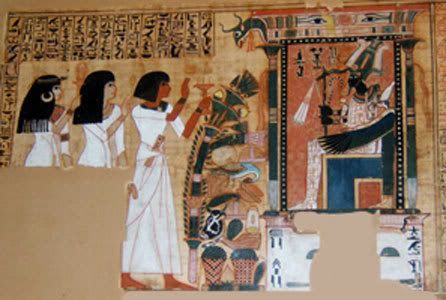 As you can see, in this last picture Osiris has the wings of a black bird instead of arms. Are we then supposed to believe that the ancient Egyptians were black winged creatures? That way lies folly and Stitchin and Nephilim ....!!! Funny how the historians who believe that Osiris and Isis were once King and Queen of Egypt never mention those wings! No, every single aspect of an ancient Egyptian religious painting or amulet is symbolic and not historic, including the colour. In traditional Egyptian art, “Most male deities were represented with reddish brown skin; most female deities with yellow skin, similar to the skin colours used to differentiate human figures”. Robins adds that all skins colours in Egyptian religious art were symbolic. (G. Robins .2002 “Colour Symbolism” In The Ancient Gods Speak: A Guide to Egyptian Religion, ed. D. Redford, New York: Oxford University Press, pp 57-61.) The major colours portrayed are white, black, green, blue, red and brown. Except for white and black, the colours come in various shades. White (hedj or shsep) is usually reserved for mummy wrappings, clothing, temple floors and fur on animals. In most cases, white is a statement of purity and cleanliness indicating the sacred nature of the god, person or object... Black (km), unlike white, is connected with fertility and associated with Egypt or the “black land.” The yearly inundating floods blacken the land with regenerative soil. Thus Osiris, in his role as regenerator, is often portrayed as having a black face for not only does he fructify the land, he is a conduit to the resurrection of the deceased. Black, then, is not a doom or gloom colour but one representing resurrection of the land, crops and the blessed dead. Green (wzd) incorporates many shades including blue. The colour green, like black, was used to denote resurrection, as Osiris if often portrayed with a green face; green and black can be analogous colours. Green represents regeneration in the form of vegetation and the renewing of life. Frequently, the deceased’s face, as depicted in the Coffin Texts, was coloured green to insure resurrection, again, an identity with Osiris. Blue (irtiu), rare before 2550 BCE, became a significant magical colour because of the precious stones that produce it, that is: turquoise (traded from Sinai) and lapis lazuli which has a deeper blue with gold impurities. It was associated with the primordial waters and the night sky out of which sun arises at dawn. Thus Amun-Re [oldest overarching godhead – Ish] is usually portrayed with blue skin “to symbolise both his role as the creator god who came out of the primordial waters and his nightly regeneration as he passed through the primordial waters in the Underworld. Items of funerary equipment made of blue faience were the harness the regenerative properties of the colour” (Robins 2002:59). Rush. Here we see some examples of the later blue, from the time of Tutenkhamen and Nefertiti. Horus leading Nefertiti on her death journey 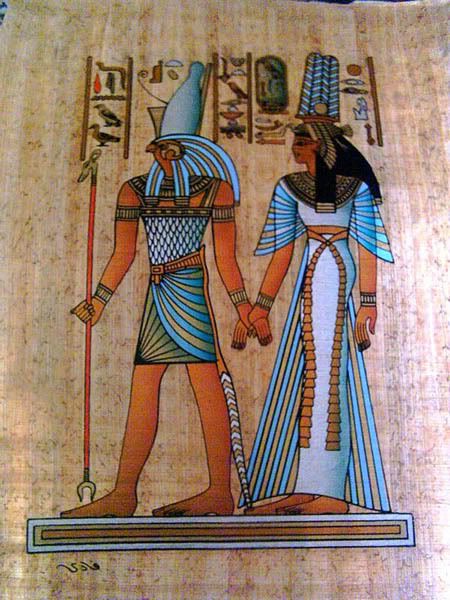 This tyet, or amulet, was found in Tutenkhamen’s tomb. It represents Isis.  Red (dsr) includes not only red but also yellow and orange, Red is considered a dangerous but life-giving colour. It is the colour of the sun, which heats the black soil and brings it to life, and is also the colour of the hair of Seth, the god of Chaos. Red is the colour of the Isis knot, an amulet often made from red jasper. Red could also bring forth the generative properties of Osiris and resurrection in the Field of Reeds. Rush Hathor 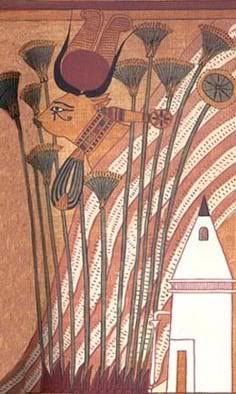 But what the hell does it all mean? So if this all seems like an impossibly complex jumble of gods and goddesses and symbols, hopefully I can simplify it in just a few paragraphs. In the death journey, the deceased takes a journey where he meets many different situations, with which he has been schooled to interact in a number of different ways, in order to pass through the gates. At each gate, he meets a different god or goddess who is part of his death adventure story. He also meets a demon-like Apoph sea monster, who he has to defeat, and this dragon-slaying story has come down to us in the myths of countless storm gods conquering dragons and serpents all over the world. The deceased, if he is rich and powerful, would have had this story painted all around him on the walls of his tomb. He will also be buried with many ‘grave goods’ that have the express purpose of helping him on his journey, just like the paintings. Later on, those who weren’t so illustrious could have these texts painted on the lids of their wooden coffins, or sometimes they were buried with it in the form of a papyrus manuscript. One such was the priest called Ani, and the so-called Egyptian Book of the Dead is taken from his papyrus manuscript, called The Papyrus of Ani. Here is a classic scene from the Papyrus of Ani’s death journey. 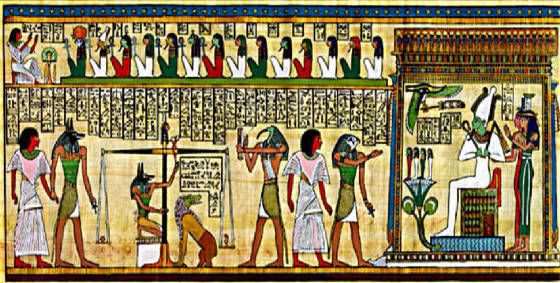 On the far left, we can see the jackal-headed god Anubis bringing the priest Ani’s wife by the hand into the judgement hall of Maat, which is presided over by the god of the Underworld, Osiris. The priest Ani is standing before Osiris and between the gods Horus and Thoth. Standing behind Osiris is his wife Isis, and her sister Nephthys. Ani is about to have his heart weighed against a feather – and if his heart is heavier than the feather (i.e. heavy with bad karma) he cannot proceed on the rest of the journey and will be eaten by the crocodile-faced beast by the scales. (There is no Hell, btw, but I wouldn't much fancy being eaten by that animal - still, it would be over quicker than an eternity in Hell!). However, if Ani passes this test, he can proceed out of the Underworld and on to next stage of his journey leading to the heavenly Field of Reeds, which is his destination. See, it’s all really quite simple once we get the historians out of the way, and we start to walk ilke an Egyptian! |
|
|
|
|
#18 |
|
|
So perhaps the next question is, does this journey really happen? Surely it's all just imagination?
Well, yes and no. When we leave our body at death, we spend some time in an intermediate stage where the realm of the imagination (for want of a better word) comes into play. The word 'imagination' has connations of 'make believe' or 'not real'. But really, the realm of imagination does exist on the quantum level, as it's the place were the seeds of all ideas are originally imaged. If I ventured in the slipstream Between the viaducts of your dream Where immobile steel rims crack And the ditch in the back roads stop Could you find me? Would you kiss-a my eyes? To lay me down In silence easy To be born again To be born again From the far side of the ocean If I put the wheels in motion And I stand with my arms behind me And I’m pushin’ on the door Could you find me? Would you kiss-a my eyes? To lay me down In silence easy To be born again To be born again There you go Standin’ with the look of avarice Talkin’ to huddie ledbetter Showin’ pictures on the wall Whisperin’ in the hall And pointin’ a finger at me There you go, there you go Standin’ in the sun darlin’ With your arms behind you And your eyes before There you go Takin’ good care of your boy Seein’ that he’s got clean clothes Puttin’ on his little red shoes I see you know he’s got clean clothes A-puttin’ on his little red shoes A-pointin’ a finger at me And here I am Standing in your sad arrest Trying to do my very best Lookin’ straight at you Comin’ through, darlin’ Yeah, yeah, yeah If I ventured in the slipstream Between the viaducts of your dreams Where immobile steel rims crack And the ditch in the back roads stop Could you find me Would you kiss-a my eyes Lay me down In silence easy To be born again To be born again To be born again In another world In another world In another time Got a home on high Ain’t nothing but a stranger in this world I’m nothing but a stranger in this world I got a home on high In another land So far away So far away Way up in the heaven Way up in the heaven Way up in the heaven Way up in the heaven In another time In another place In another time In another place Way up in the heaven Way up in the heaven We are goin’ up to heaven We are goin’ to heaven In another time In another place In another time In another place In another face Van Morrison, Astral Weeks But if you can't get your head around whether it is real or not, it doesn't really matter. It's just that by having a death journey, the spirits know where you're at, and they know where to pick you up. There is a structure and order to your leaving, and so they will know which departure gate you'll be standing at when they come to fetch you, as you've rehearsed it many times. Then they'll make sure you get on the right plane. Although most souls do make it through to where they're meant to go eventually, it's a little bit hit and miss today - especially for someone who dies suddenly, perhaps in an accident. Shamans will tell you that there are more what we call 'ghosts' around today than there have been for thousands of years. This is partly because we're no longer taught what to do at death, and partly because so many more die suddenly in wars now with such sophisticated weaponry, or in car accidents or plane accidents. Shamans call this The Pile-Up. A shaman can help you by acting as a psychopomp - i.e. they can you carry you through, but you have to let one know that you want this. The reason the Tibetans, the Indians and the Egyptians had 'death manuals' (and probably many more civs, we just haven't found them) was because their shaman or rishi teachers understood the importance of knowing what you're doing at death. In Tibet, when the person was dying, a designated monk would sit beside and guide them through with his voice, taking them all the different bardots or dimensions. Eventually, these death guidances were written into manuscripts and after some time, published as The Tibetan Book of the Dead. These teachings are attributed to Tibetan Buddhism. But Buddhism is just a late entrant into Tibet where it took over from Bon shamans in the early CEs, and the Bon shamans would have been guiding these death journeys for millennia before that. I'm sure there were other 'death books', but they have yet to be discovered. |
|
|
|
|
#19 |
|
|
I'm sure there were other 'death books', but they have yet to be discovered. There is a news story today about one of these Book of the Dead papyruses (papayrii?) being discovered and it is being restored at the Royal Ontario Museum in Canada. There's also a quite fascinating video showing how they restore it. The papyrus of Amen-em-hat, which dates to around 300 BC, has just received a new a lease of new life. Part of the papyrus had been on display in the Royal Ontario Museum for many years but lying hidden in the storage vaults of the museum was another large section of the papyrus, still rolled up as it was when it was buried with the body of the ancient Egyptian King thousands of years ago. It wasn’t until a student from the German University of Bonn set an enquiry in 2003 to the ROM that it was realised they’ve been in possession of the rest of the papyrus since it was given to the Museum a hundred years ago. Roberta Shaw explains in the following videos from the ROM ’s website: Go here for the story, pictures and video |
|
|
|
|
#20 |
|
|
... this time on the walls of a newly excavated tomb, that of he tomb of Gahouti, the head of the treasury under Queen Hatshepsut c. 3,500 years ago.
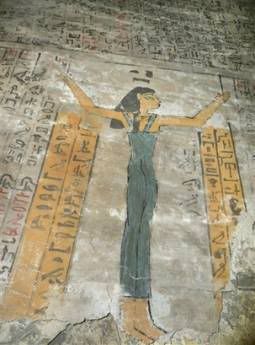 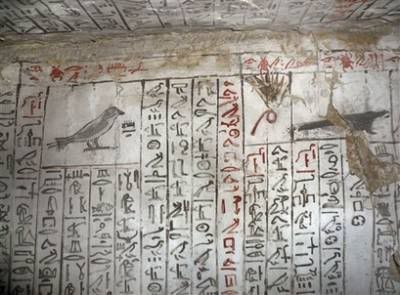 CAIRO – Egyptian officials says archaeologists have found ancient golden jewelry in a pharaonic-era tomb that belonged to a senior official under Egypt's most powerful queen. The Supreme Council of Antiquities says five golden earrings and two rings were found in the tomb of Gahouti, the head of the treasury under Queen Hatshepsut, who ruled Egypt 3,500 years ago. Tuesday's statement says the tomb was located on the west bank of the Nile River in Luxor, a southern Egyptian city famous for its Valley of the Kings and other ruins from pharaonic times. The tomb had been looted, and its gates were engraved with text from the "Book of the Dead," which Egyptians believed would be needed in the afterlife. 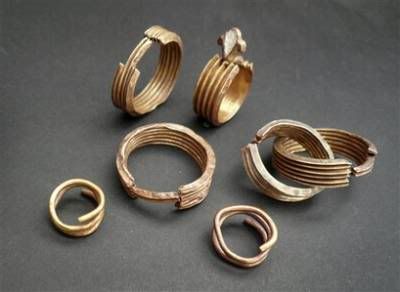 From here |
|
|
| Reply to Thread New Thread |
«
Previous Thread
|
Next Thread
»
| Currently Active Users Viewing This Thread: 1 (0 members and 1 guests) | |
|
|






 Linear Mode
Linear Mode


